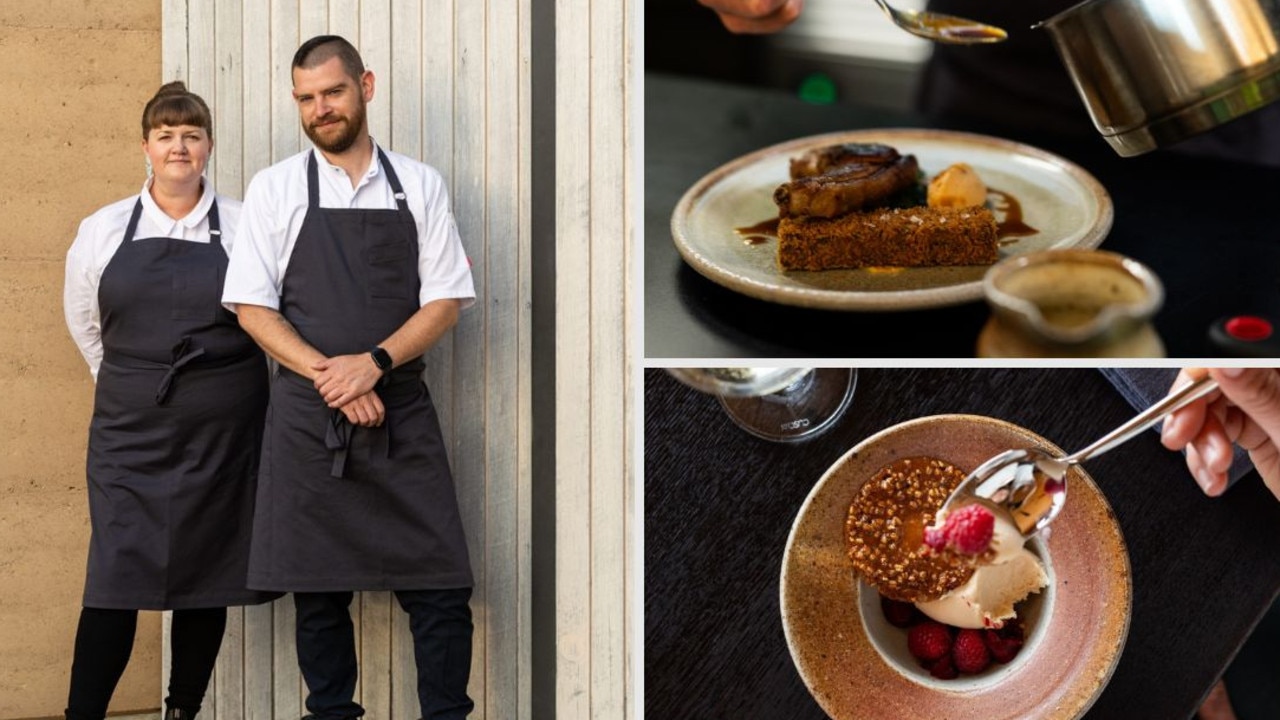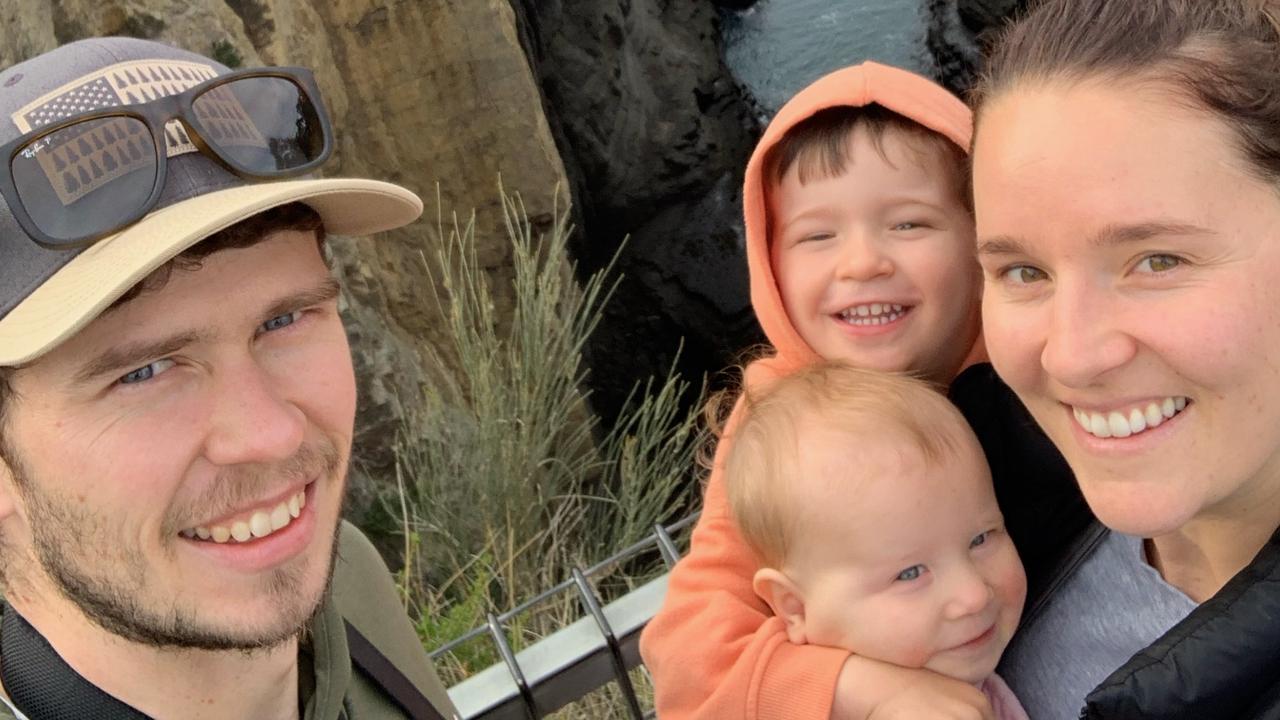Courting controversy in the hall of Tasmania’s mountain king
Meet the couple at the centre of a storm over plans to build on a flyfishing tourism business in the Walls of Jerusalem National Park
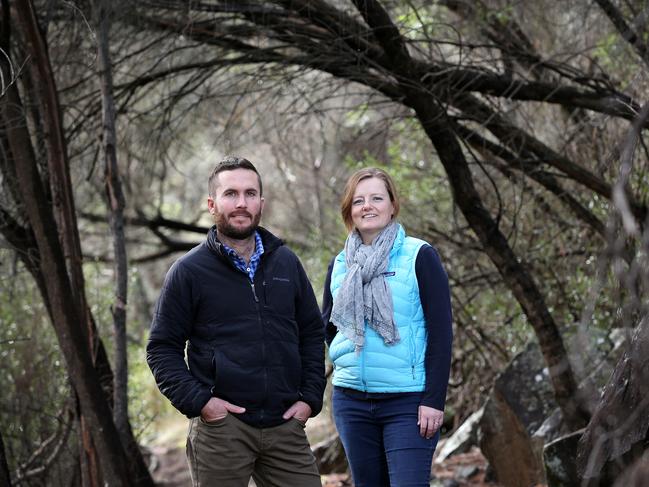
Travel
Don't miss out on the headlines from Travel. Followed categories will be added to My News.
ANYONE who has heard of the Palin effect (that’s Michael Palin whose travel doccos spawned travellers to inundate the places he visited) will be familiar with the phrase “loving a place to death”.
David Attenborough’s wilderness documentary Tasmania has just screened on ABC TV. It couldn’t happen here in Tasmania. Could it?
When the Hodgman Government opened an Expressions of Interest process into wilderness tourism ventures in 2015 — a process ongoing through the Co-ordinator General’s office — Tasmanians Daniel and Simone Hackett were running guided fly-fishing tours in the Western Lakes (aka “Land of 3000 Lakes”).
Their custom-designed standing camp continues to attract anglers from around the world, and has earned accolades in both state and national tourism awards (including the prestigious 2016 Qantas Australian Tourism Award).
Now, while awaiting the legally binding outcome of a federal Environmental Protection and Biodiversity Conservation Act assessment into their latest tourism venture on Halls Island, the Hacketts have found themselves at the centre of a difference of opinion about what is or isn’t allowed in the Tasmanian Wilderness World Heritage Area.
Their new proposal is for a four-day, three-night island retreat for people who want an authentic cultural experience in a wild place combined with privacy — and are prepared to pay. Daniel Hackett says: “At this stage we are midway through the EPBC Assessment process, which includes a second round of formal public comment and assessment.”
An introduction by flyfisher and author Greg French in 2015 led to Daniel being offered custodianship of a hut and 8ha island in Lake Malbena in the Walls of Jerusalem National Park.
Since 1979, Halls Island had been in the hands of former Hobart teacher and poet Liz McQuilkin. Liz is the daughter of Reg Hall (1907—1981), mountaineer, cartographer, designer and inventor, famed in bushwalking circles as The Weindorfer of the Walls.
Reg had been a lover and explorer of the Walls since 1927 and set his heart on building a secret hideaway. It took two summers to build the hut on an island in the middle of a lake, cutting his first post in 1953. Here he lived his second life for two months a year for more than 25 years. His first life was as a barrister in Launceston.
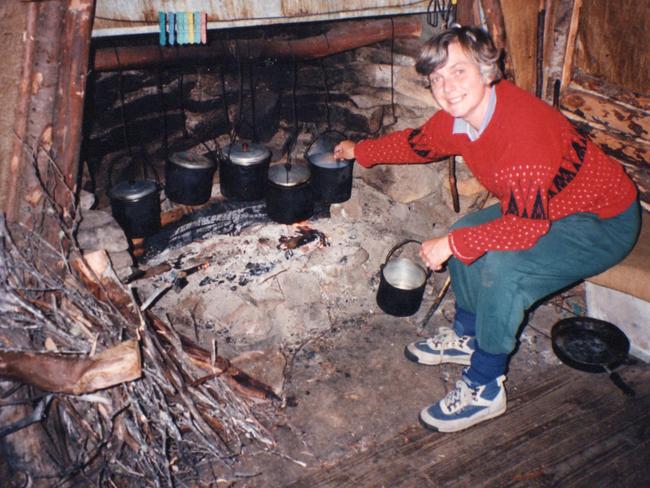
Reg made meticulous maps of his explorations of the mountains. His 1935 map of Frenchmans Cap was the first to contain details of heights, contours and bearings, along with notes on vegetation, geology, and how to reach Daverns Cave.
He designed and made tents, clothing, rucksacks, stoves, even a collapsible canoe — currently under the protection of Launceston’s Queen Victoria Museum & Art Gallery.
For years Liz says she worried an overseas consortium might take over the licence and build a five-star hotel. When Greg French introduced her to Daniel Hackett as a potential custodian, she consulted the late Simon Cubit for a second opinion. “Simon had a deep understanding of the highlands,” says Liz. “He told me I couldn’t have chosen a better person than Dan Hackett and that he would look after the island.”
Daniel, who has formal qualifications in aquaculture and fisheries management from the University of Tasmania (where he and Simone met), is an experienced Western Lakes’ guide. He first visited the area as an 18-year-old and began guiding commercially in 2005.
“We started RiverFly1864 at the age of 25 with no money,” says Simone. “All we had was 250 business cards.”
“With climate change we needed to find somewhere sustainable for the long term,” says Daniel. “The big drought coincided with the food-bowl era of Tasmania which, translated into more irrigation from the rivers we earned our living from. So, the drought-resistant Central Plateau became the place for us.”
For the first three years, RiverFly1864 operated fly fishing based from a nominated site at Christys Creek (in the Western Lakes/Central Plateau at Lake Ada) staying in tents they carried in. After three seasons, Hackett says they decided to provide “a more environmentally sensitive operation befitting of the World Heritage area by getting customers off the ground (to protect from pad formation and trampling), and using a toilet to capture all waste”.
This led to the standing camp concept, and an agreement negotiated in 2012 with the Tasmanian Land Conservancy at Skullbone Plains, 25km west of Bronte Park.
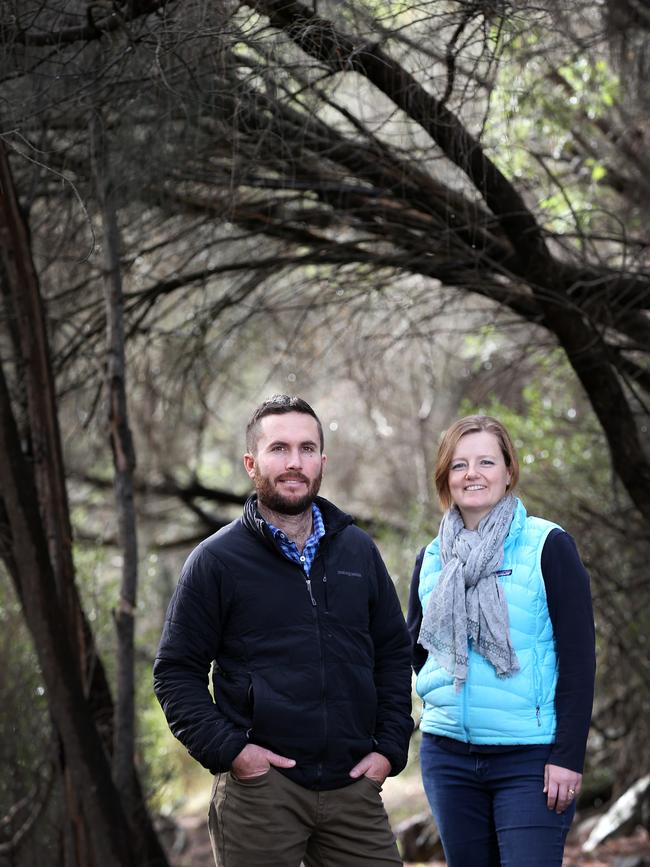
RiverFly1864 custom-built four steel-sided, hybrid huts — designed to withstand wind, snow load, moisture, and animals chewing through canvas. Friends helped carry materials to the site and put the camp together over a two-month period.
“Carrying in four tonnes over a couple of kilometres was character building to say the least,” says Daniel. Meanwhile, Simone was back home with a three-month-old baby, running RiverFly’s retail outlet in Launceston (which has since closed so they can focus on their Halls Island proposal).
The Western Lakes Huts operation was an outcome of the end of the forestry industry in Tasmania. Formerly owned by Gunns, the land became part of the World Heritage Area after the extension of the forestry agreement. “We were already there when it became part of the World Heritage Area,” says Daniel, “so it was a big tick of approval for our operation.”
At Lake Malbena, in another part of the Tasmanian Wilderness World Heritage Area, the Wilderness Society’s Vica Bayley has questioned the transparency of the process which saw Lake Malbena moved out of the Wilderness zone in the 2014 Draft Management Plan to the Self-Reliant Recreation Zone in the final plan of 2016. “Like Gunns and Hydro,” says Bayley, “tourism is the new pet industry in the process of over reaching.”
We meet the helicopter at a Derwent Bridge carpark outside the Cradle Mountain-Lake St Clair National Park for the 12-minute flight to Malbena. The route, says Daniel, “avoids humans and eagles”.
“We’ve worked really hard to find a route that minimises impacts, avoiding walking tracks. The route is predominantly thick scrub and tea-tree understorey where few people go. In a general sense I don’t think helicopters are appropriate for the World Heritage Area, but it’s not helpful that helicopters are seen as a big evil thing rather than a tool that can aid in sustainability for our operation,” he says.
“Hello old friend.” Daniel greets Reg’s old hut with its distinctive A-shaped ladder hewn from three branches. He’s visiting with an architect and ecologist to further assess the proposed site for a standing camp on the island, and a helicopter landing site on the mainland to the east of the island.
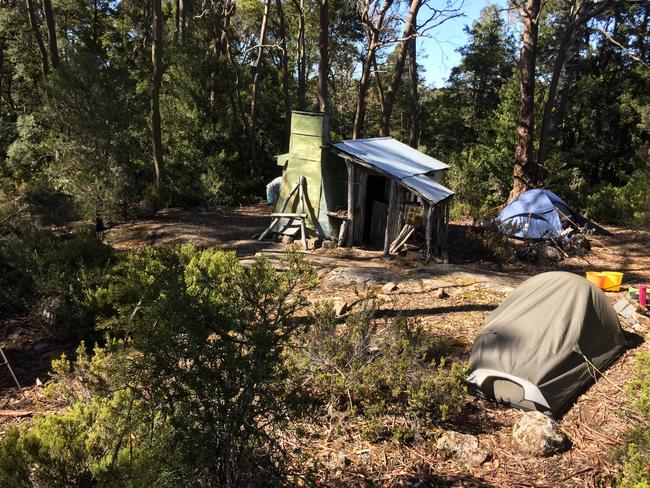
If the project is approved, in order to minimise impacts, guests will be flown by helicopter at 3000ft from Derwent Bridge to the landing site. Helicopter use will be limited to facilitate 25 bookings in summer and five in winter. Guests will be transported to the island by rowboat, arrive at the natural rock jetty, and make their way to the existing hut where the landscape will remain unaltered. Three accommodation pods will be built nearby, similar in size to the standing camp at Skullbone, along with a small, communal pod housing a dining facility and kitchenette designed to mimic the huddled-together space inside Reg’s hut.
“Our pods will facilitate basic needs,” says Daniel. “We want people to get out, explore the island, use the row boat and kayaks on the lake, go bushwalking, spot the native birdlife … It’s an area that hasn’t been studied too much and we want to facilitate that and continue to feed back information to the museum.”
The Queen Victoria Museum and Art Gallery in Launceston is curating an exhibition that will feature the flora and fauna of Halls Island, Reg’s maps, designs and photos of the Central Highlands and Walls of Jerusalem, and many of Reg’s possessions.
Architect Todd Henderson, director and principal of Cumulus Studios (who cut their wilderness teeth on Pumphouse Point with Simon Currant) smiles as he observes Reg’s hut for the first time.
Henderson recalls his father’s love of fishing in the Central Highlands but, like many, had no knowledge of the island hut.
“I feel quite privileged being here. Every part of it has been thought through, down to every nail. It’s all he needed, that’s why the detail is like it is. In terms of the history of Reg being on the island, it is a really important building.”
Henderson says the new structures will be a recessive element in the landscape, “like a silhouette”, made from lightweight, non-reflective material (the same fibreglass-reinforced plastic blend that Parks is now using for boardwalks), and designed to be built off site, dismantled, and reassembled on site. Doorways will be the same height as the hut (Reg was only 170cm, or 5 foot 7 inches tall), so you duck your head when you go inside.
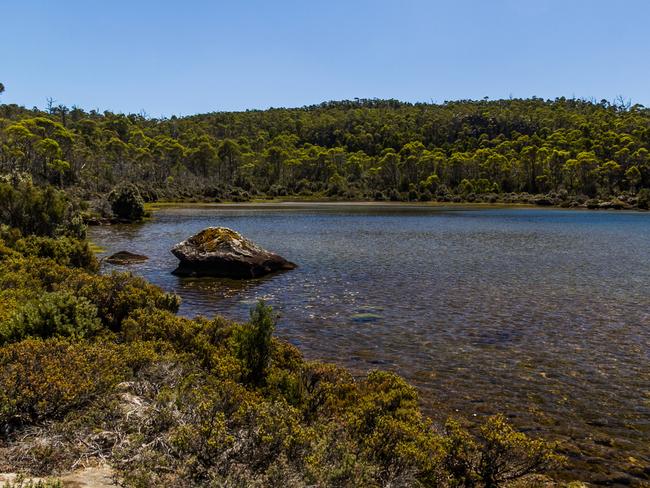
Andrew North from North Barker Ecosystem Services is also visiting the island to assess the heli-landing site off island.
He understands concerns that the Halls Island proposal is opening the way to others and this may be a challenge for people who have taken a personal view on development in the World Heritage Area. However, he says their role is to provide data for the EPBC assessment for this particular project.
Inaccurate reports claimed the plan was to operate heli-fishing in the Walls. “It’s never been about heli-fishing,” says Daniel.
“Malbena is not a good fishery compared to the area around Skullbone where hardcore anglers want to get out into the weather and experience the wild fishery.”
He says the Halls Island proposal is different, describing it as “Wilderness and Conservation tourism Tassie 2.0”.
Last week, Hackett was invited by the Corralinn Fly Fishing and Casting Association to address 30 members about the Halls Island proposal. President Chris Cohen said although his conservative membership was unlikely to be remote-area fishers, they were “quite impressed” with the proposal.
“You keep hearing the comment ‘thin edge of the wedge’, but I think Daniel’s project has the chance of stacking up,” Cohen says, “because it limits helicopter use and the location of the route seems quite reasonable. It’s not a prime fishing area he’s flying over. Halls Island is basically a one-off that I feel extremely fortunate to have visited in 2002.”
Daniel climbs the hut ladder to replace the chimney cover left off by previous visitors. He says it doesn’t help if people let in rain or possums.
Since Reg’s day, the Halls Island guest-book was signed by bushwalkers who visited and enjoyed one of the remotest of places, hiking with packs and tents for eight hours on heavily vegetated, overgrown tracks, often difficult to discern.
What do Daniel and Simone tell people who think access should remain as it is, for walkers prepared to walk in?
“Not everyone has the physical ability to walk in,” says Simone. “You’ve also now got a younger, urbanised generation, extremely time-poor, with no bush skills. They can’t cope with that level of hiking and might not even want to. Just because they experience places differently, doesn’t mean they shouldn’t be allowed there.”
Along with the commercial offering, their plan is to continue to allow visitation to responsible people, especially bushwalking clubs, with numbers set to guest-book levels of the past 25 years.
Former Greens leader Bob Brown has told Daniel Hackett there should be no buildings — even existing ones — within the World Heritage Area, and that he will never set foot on Halls Island.
Vica Bayley says Lake Malbena would be degraded by the construction of buildings and the flights of helicopters. “We see the biggest impact of mechanised access being on the wilderness, and on the wilderness experience of other users, and, as such, we are opposed to the project,” he told TasWeekend.
Bayley, who has never visited Lake Malbena, says, “You don’t have to ever go to wilderness areas to appreciate them.” He says RiverFly’s proposal for “high-end luxury access to see a hut that has been privatised and commercialised” is not a vision he wants for Tasmania’s National Parks and Reserves. “Whatever the benefit it comes at a conservation cost,” says Bayley. “No presence is good presence.”
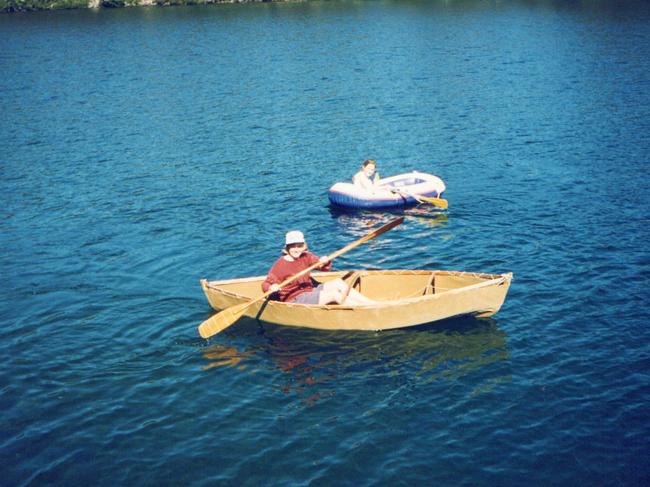
But Reg Hall’s presence is palpable: an old pair of boots greets you at the door, a shelf of well-read paperbacks, the simple hessian bunk where he slept … For 25 years Reg spent a total of two months a year living on the island, mostly accessed by walking, except when he became ill and travelled in by horseback. Twice he visited by amphibian seaplane. Daniel says describing the area as “wilderness” ignores its human use.
Last year Liz McQuilkin visited Halls Island for the first time in 20 years, travelling by helicopter from Hobart.
Liz recalls how in the early 1950s her father (then on the Scenic Preservation Board) tried to buy the island but the Lands Department turned him down because the Hydro had plans to flood the Nive basin (which included Lake Malbena). If the island was owned the lake could not be flooded.
Reg negotiated an annual licence instead, paying an annual fee for using the hut discreetly while exploring the lakes and mountains and enjoying the fauna and flora of the island.
Much later the Central Highlands Council decided to charge rates (which continue to apply today).
As the hut’s former owner-custodian, Liz supports the Halls Island proposal, “as long as helicopter flights are kept to a minimum and accommodation is basic”. She says, “It’s better to have a little bit of presence on the island to save it.”
Daniel and Simone are aware the hut is in urgent need of repair: floor joists require replacing, and one or two tall yellow gums look close to coming down on top of it or nearby.
“Our oral and human histories are disappearing, along with our knowledge of old ways,” says Daniel.
“If we want to carry on the important stories that make us all Tasmanian, and we want heritage structures to survive and be celebrated, we’re going to have to do things a bit differently. Surely part of that journey is to acknowledge and share this important culture through responsible tourism?
Hilary Burden has visited Halls Island twice as a guest of RiverFly1864, first in January 2017, when she walked in with a group that included QVMAG curators and camped on the island, and, most recently via helicopter last month.

